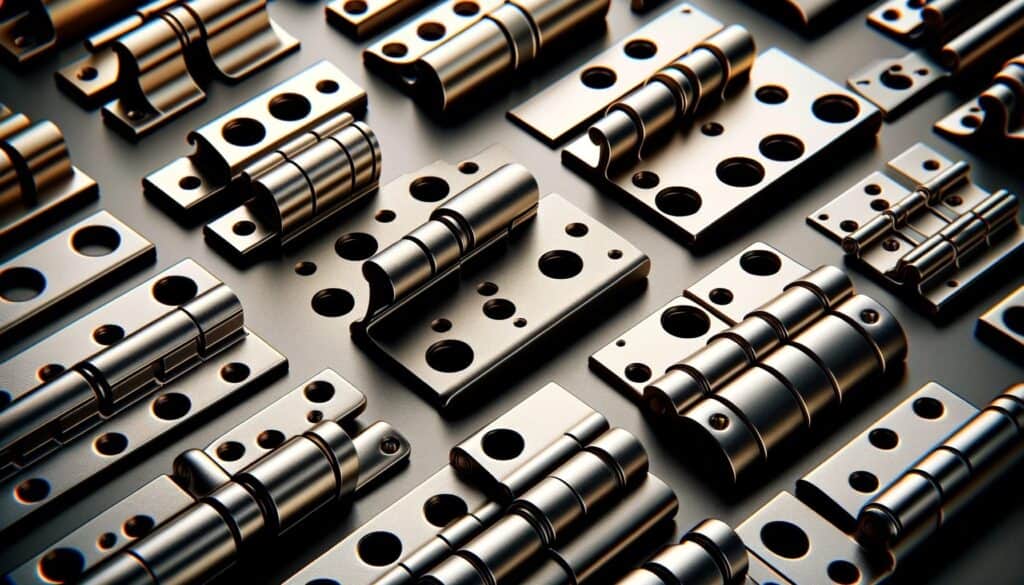
Have you ever tried fitting a square peg into a round hole? It can be a frustrating experience that makes you question the importance of standard sizes.
So, let’s talk about door hinge holes. Are they standardized? This seemingly simple question can lead to confusion and uncertainty. As someone who has explored the world of door hardware, I can tell you that the answer is not as straightforward as we might hope.
But don’t worry, I’m here to provide some clarity on this matter and guide you through the maze of door hinge holes. Let’s take a closer look together and uncover the truth.
Key Takeaways
The size commonly used for door hinge holes is 35mm in diameter for kitchen cabinet doors. However, it’s important to note that hinge size requirements may vary depending on the manufacturer or specific application.
Accurate measurements and precise placement of hinge holes are crucial for the smooth functioning of doors. Paying attention to detail is key when measuring, determining door handling, or locating hinge holes.
Measuring Hinge Holes
To measure hinge holes accurately, you need to be familiar with the dimensions of the existing hinge holes, including their diameter and depth. The size and placement of the new hinge holes are determined by the existing hinges.
When measuring the hinge holes, make sure to accurately measure the distance from the top or bottom for each pair of holes. This ensures proper alignment and functionality of the hinges.
Standard hinge holes usually have a diameter of 1.375 inches (38mm) and a depth of 1/2 inch (12.7mm). However, it’s important to verify the door specifications and dimensions as some doors may have different requirements.
When ordering new hinges, confirm any specific requests for new holes or spacing to ensure a seamless installation.
Concealed Hinge
When discussing concealed hinges, it’s important to understand the installation process and the benefits they offer.
Concealed hinges provide a sleek and modern look, making them a popular choice for kitchen, bedroom, bathroom, and built-in cupboards.
These hinges come in two sizes, with the 35mm diameter being the most common, and the 26mm diameter offering flexibility for smaller cabinets or budget carcasses.
Installation Process Explained

Concealed hinges are commonly used in kitchens, bedrooms, bathrooms, and built-in cupboards. They come in two sizes – 35mm diameter and 26mm diameter hole size, with the 35mm hinge being the most commonly used.
The installation process for concealed hinges requires precise measurements and careful drilling of the hinge holes in both the door and the cabinet. There are specific measuring points for the top and bottom hinge holes, which are illustrated in a sample. In new builds, hinge hole positions can be entered even if they aren’t critical.
The dimensions of a typical door hole for a concealed hinge are centred 22.5mm from the front with a 35mm diameter hole. However, the height distance may vary between manufacturers and should be verified.
When installing concealed hinges, it’s important to consider the door handling, whether it’s a left-hung door or a right-hung door. Additionally, doors of the same size, some with pre-drilled hinge holes and others without, should be ordered as separate panels to ensure proper installation.
Benefits of Concealed Hinges
Concealed hinges offer a modern and stylish look while improving the overall appearance of cabinets and doors. These hinges have many advantages that make them a popular choice in furniture and interior design.
First, concealed hinges are visually appealing as they hide the hardware, creating a clean and seamless appearance.
They’re also easy to adjust, allowing for precise fine-tuning of the door’s position and alignment.
The smooth operation of concealed hinges ensures quiet door movement, reducing noise and providing a seamless user experience.
Additionally, these hinges save space by not protruding and maximizing the usable space in cabinets or rooms.
Lastly, concealed hinges are designed for durability, often equipped with high-quality mechanisms that contribute to their long-lasting performance.
Measuring Points From Top
Typically, the top hinge is installed 5 inches down from the top jamb or edge of the door. This measurement is a common practice when installing door hinge holes.
When determining the measuring points for the top hinge hole, it’s helpful to refer to a sample that provides the necessary measurements. In a new build where four holes are required, it’s possible to enter positions even if they aren’t critical. However, for centre holes, it’s important to measure accurately from the top. In these cases, you can simply enter ‘cen’ or ‘centre’ to indicate the measurement point.
For doors with four holes, the upper two holes require a distance from the top, while the lower two holes require a distance from the bottom.
Following these guidelines ensures that the door hinge holes are aligned correctly and adhere to industry standards.
Sample Dimensions of Typical Door Hole
The dimensions of a typical door hinge hole are important for proper installation and alignment of the door hinges. When fitting front cabinet doors, the hinge holes are usually centred 22.5mm from the front with a 35mm diameter hole.
However, it’s important to note that the height distance may vary between manufacturers, so it should be checked before drilling. If you have an existing door and the hinge is 26mm in diameter, the hole centre should be 18mm.
These specific dimensions ensure that the door hinges fit perfectly and function smoothly. Before drilling any holes, it’s essential to confirm the exact dimensions with the manufacturer to avoid any mistakes.
Additionally, small screw holes may also be required for added stability and security.
Door Handling for Hinge Holes

When determining the door handling for hinge holes, it’s important to establish whether the door is left-hung or right-hung in order to select the appropriate hinge.
The placement of the hinge holes will vary depending on the door handling, ensuring proper installation and function.
This consideration is crucial for achieving a seamless and functional door system.
Left or Right Handed?
To properly install a door and its hardware, including the correct placement of hinge holes, it’s important to determine whether the door is left or right-handed. The door’s handling refers to the side where the hinges are located when standing outside the room or building and facing the door.
A left-handed door has the hinges on the left side, while a right-handed door has the hinges on the right side. When ordering pre-drilled doors, it’s crucial to specify the handling to ensure the accurate placement of hinge holes.
This information is essential because the handing of the door also determines the swing direction, whether it opens to the left or right. By determining whether the door is left or right-handed, you can ensure that the hinge holes align properly with the existing door frame or jamb.
Hinge Hole Placement
Proper placement of hinge holes is crucial for the accurate installation of a door and determining its swing direction (left or right). There are industry standards to consider when it comes to hinge-hole placement.
The height of the door is a key factor in determining where the hinge holes should be positioned. Typically, for standard doors, the top hinge hole is placed 5 inches from the top edge of the door, while the bottom hinge hole is positioned 10 inches from the bottom edge. However, these measurements may vary depending on the door’s height.
To ensure precise hinge hole placement for your specific door height, it’s advisable to consult industry standards or guidelines.
Examples of Edge Locations of 35mm Hinge Holes
In the standard placement of 35mm hinge holes, the edge locations are usually centred 22.5mm from the edge for precise and consistent measurements.
Here are some examples of edge locations for 35mm hinge holes:
- For 35mm cup concealed hinges, there’s typically a 5mm distance between the door edge and the hole, indicating the 22.5mm centre.
- In carcasses that are 18mm thick, the 35mm hole positions are usually 22.5mm apart, following standard measurements.
- However, for 15mm thick carcasses, the 35mm hinge holes are more likely to be positioned approximately 20mm from the edge.
It’s important to note that small screw holes shouldn’t be used as a guide for 35mm hinge hole placement, as they can vary from hinge to hinge.
Ensuring the correct edge locations of 35mm hinge holes is crucial for the proper installation and functionality of door hardware.
Door Hinge Holes Locations From a Carcass

The proper installation and functionality of door hardware rely on accurately positioning the door hinge holes on a carcass. To determine these locations, it’s important to consider the size and weight of the door.
For a standard residential door, three hinges are typically used. The top hinge is installed 5 inches down from the top jamb, the bottom hinge is positioned 10 inches up from the finished floor, and the third hinge is centred between them.
The number of hinges needed should also be based on the size and weight of the door. As a general guideline, one hinge should be used for every 30 inches of door length.
Working Out the Top Hinge Hole Locations From a Carcass
To accurately determine the location of the top hinge hole on a carcass, you need to measure the distance from the top of the door. This ensures correct placement and alignment with the other hinge holes.
Here are the steps to determine the top hinge hole locations:
- For carcasses with four-hole hinge setups, measure the distance from the top for the upper two holes and from the bottom for the lower two holes.
- In a new build with four holes, enter positions even if they aren’t critical.
- Center hinge holes require measurements from the top, and you can enter ‘cen’ or ‘centre’ for this type of placement.
Frequently Asked Questions
Are All Hinge Holes the Same Size?
Hinge hole sizes can vary depending on factors such as the type of door, the size of the hinge, and the type of corner. Different variations of hinge holes for doors include round or square corners and sizes like 3-1/2 x 3-1/2 or 4 x 4 inches.
Are Door Hinge Locations Standard?
Door hinge locations generally adhere to standard construction practices. Typically, they are placed 5 inches down from the top jamb, 10 inches up from the bottom edge, and centred between the top and bottom hinges.
Are Door Hinges Universal?
Door hinges are not universal. They come in different designs, sizes, and corner types. It is important to ensure that the door hinges are compatible with the door and to customize their placement based on the door’s size, weight, and construction standards.
Are All Door Hinges in the Same Spot?
Proper alignment of doors is essential for smooth operation. When installing door hinges, make sure they are securely attached to both the frame and the door. Common issues that may arise include sagging, misalignment, and squeaking. These problems can be resolved by either replacing or adjusting the hinges.
Is the Size and Placement of Door Hinge Holes Standardized?
Yes, the size and placement of door hinge holes are standardized to accommodate universally sized door hinge pins. This allows for seamless installation and replacement of door hinges without the need for customized hardware. The standardized dimensions ensure compatibility across different door types and styles.
Concluding Thoughts on the Standardization of Door Hinge Holes

The standard size for door hinge holes is typically 35mm in diameter for kitchen cabinet doors. However, it’s important to note that hinge size requirements may vary depending on the manufacturer or specific application.
Accurate measurements and precise placement of hinge holes are crucial for the smooth functioning of doors. Attention to detail is key when measuring, determining door handling, or locating hinge holes.

Hi, I’m George Anderson, an expert installer with an extensive door installation and maintenance background. I’m passionate about sharing my knowledge on door equipment and accessories through my writing, helping homeowners make informed decisions. My specialty lies in custom door installations, with a commitment to enhancing the aesthetics of every home. Please feel free to reach out anytime for help with door-related questions or needs.










